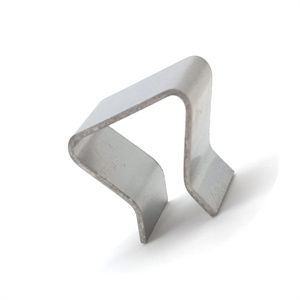The commonly used materials for U-clip fasteners mainly include the following:
Carbon Steel:
High strength and rigidity, relatively low cost. Commonly used in general machinery manufacturing and construction.
Metallic U-Clip Fasteners made of carbon steel are used in some common equipment assembly and non-critical parts fixing.
Stainless Steel:
Good corrosion resistance, suitable for use in wet, chemically corrosive environments.
Commonly used in food processing, chemical and marine industries. Stainless steel’s Metal U-ClipFastener resists seawater erosion in the fixings of marine vessels’ components.
Aluminum alloy:
Light weight, certain strength, good conductivity and thermal conductivity.
Commonly used in aerospace, electronic equipment and other areas with strict weight requirements. Like some light electronic equipment where internal components are fixed, it may be selected
Metallic U-Clip Fasteners for Aluminum.
Copper alloy:
Good conductivity and thermal conductivity, commonly used in electrical and electronic fields.
For example, in some high-precision electronic instruments, Metal U-Clip Fastener of copper alloy can guarantee good electrical contact performance.
Titanium alloys:
High strength, low weight, excellent corrosion resistance and high temperature performance.
However, it is expensive and is often used for special fastening requirements in highly sophisticated industrial areas such as aerospace.
Aluminum alloy: Aluminum alloy has the characteristics of light weight, high strength and corrosion resistance, so in some occasions where weight is required, aluminum alloy is an ideal material for manufacturing U-clamp fasteners.
When choosing the material of the clevis fastener, it is necessary to consider factors such as the use environment, load requirements, corrosion resistance, and cost. Different materials have different advantages and disadvantages, and should be selected according to the actual situation. At the same time, in order to ensure the performance and safety of the U-clamp fastener, high-quality materials that meet the relevant standards and specifications should be selected, and the quality should be strictly controlled during the manufacturing process.
